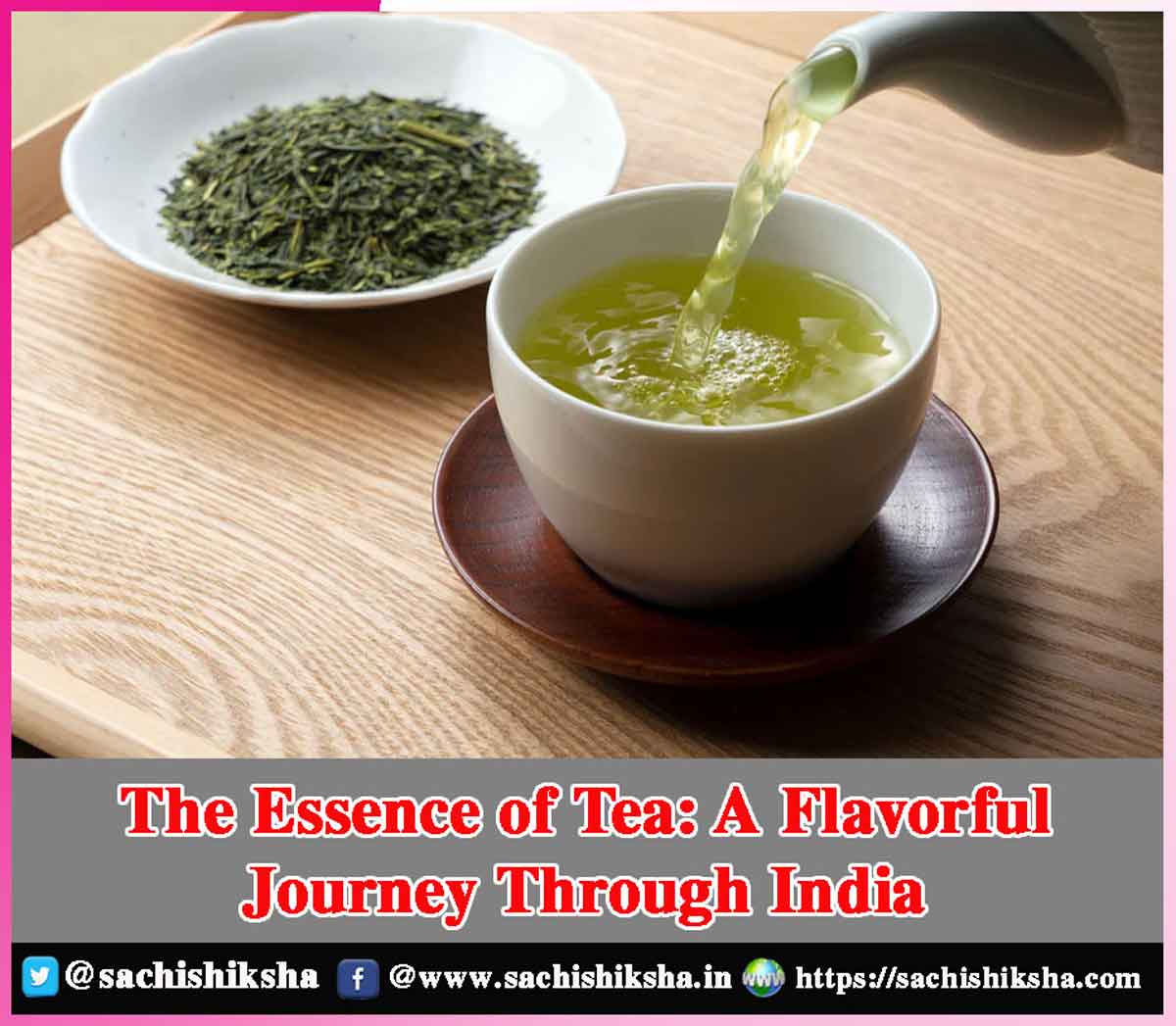The Essence of Tea: A Flavorful Journey Through India
Introduction : Tea, a beverage cherished across the globe for its diverse flavors, rich history, and cultural significance, takes on a particular dimension when explored in the context of India.
The subcontinent’s tea culture has a unique story that unfolds through the lush tea gardens, ancient traditions, and distinct regional variations. In this exploration, we delve into the essence of tea in India, tracing its roots, understanding the cultivation process, and savouring the diverse flavours that define this aromatic journey.
Table of Contents
Historical Tapestry: The Origins of Tea in India
The 19th century marked the beginning of India’s tea adventure with the introduction of tea cultivation by the British East India Company. Initially, tea was cultivated in Assam, a north-eastern state, where the indigenous Camellia sinensis var. assamica plant thrived. Gradually, the tea industry expanded to other regions, including Darjeeling in the Himalayas and Nilgiri in the southern Western Ghats.
Tea plantations became integral to the Indian landscape, and the industry burgeoned with time. The historical backdrop intertwines colonial influence, the impact of pioneering planters, and the evolution of tea as a significant economic commodity for the country.
The Geography of Flavour: A Regional Perspective
India’s vast and varied topography, from the misty Himalayan slopes to the tropical plains, contributes to the diverse flavours found in Indian tea. Each region imparts unique characteristics to the tea leaves, creating a tapestry of tastes that captivate connoisseurs worldwide.
Assam: The Bold and Robust:
Assam, known for its robust and full-bodied teas, is characterized by low elevation, high rainfall, and fertile plains. Assam tea has become synonymous with the region with its distinct malty flavour. The briskness and strength of Assam teas make them ideal for breakfast blends and are often used as the base for popular English Breakfast teas.
Darjeeling: The Champagne of Teas:

Tucked away in the Himalayan foothills, Darjeeling is renowned as the “Champagne of Teas.” The high-altitude gardens, cool temperatures, and misty terrain contribute to the unique flavour that defines Darjeeling tea. With delicate floral notes, Darjeeling teas are often considered among the finest in the world. Each flush – first, second, and autumn – brings a nuanced taste profile, making Darjeeling teas highly sought after by discerning tea enthusiasts.
Nilgiri: The Fragrant Elevation:
The Nilgiri region, situated in southern India, is known for its fragrant and brisk teas. The high elevation and cool climate of the Nilgiri hills contribute to the distinctive briskness and floral aroma of Nilgiri teas. These teas are often used in blends, and their versatility makes them suitable for both black and green tea enthusiasts.
Cultivation and Processing: From Leaf to Cup
The path tea takes from the leaf to the cup involves a meticulous process that combines traditional methods with modern techniques. The cultivation and processing of tea leaves are crucial stages that contribute to the final flavour profile of the beverage.
Cultivation: Nurturing the Tea Bush:
Tea cultivation begins with selecting suitable terrain where the tea bushes can thrive. The choice of elevation, soil quality, and climate are crucial in defining the tea’s qualities. In India, the two primary varieties of tea plants are Camellia sinensis var. assamica and Camellia sinensis var. sinensis, each offering distinct flavours.
The cultivation process involves carefully pruning, plucking, and maintaining the tea bushes. Different regions follow varied cultivation practices to optimize the unique characteristics of their tea leaves.
Plucking and Sorting: Handcrafting Excellence:
Tea leaves are typically plucked by hand to ensure the delicate buds and leaves are harvested at their optimal stage. The plucking process, often done by skilled workers, involves selecting the correct set of leaves to maintain the desired flavour. After plucking, the leaves undergo sorting based on size and quality, ensuring consistency in the final product.
Withering, Rolling, and Oxidation: Crafting Flavour:
The next stage involves withering, where the plucked leaves lose moisture, becoming pliable for further processing. Rolling, a crucial step breaks down the cell walls and initiates oxidation. Oxidation, or fermentation, is controlled to develop specific flavours – minimal for green tea, moderate for oolong, and extensive for black tea.
Drying and Sorting: Preserving Freshness:
Once the desired oxidation level is achieved, the tea leaves undergo drying to halt the fermentation process. This step helps preserve the freshness of the leaves and locks in the developed flavours. The final sorting ensures that only the highest quality leaves make it to the packaged product, maintaining consistency and excellence.
Tea Culture: A Ritual of Refreshment
Beyond the cultivation and processing, the essence of tea in India is deeply intertwined with its cultural significance. Tea is not merely a beverage but a ritual, a social activity that brings people together.
Chai Culture: Spices and Conversations:
In India, ‘chai’ refers to a specific preparation of spices, milk, sugar, and strong black tea. Chai is more than just a beverage; it is a cultural phenomenon that permeates every corner of Indian society. Whether sipped from small roadside stalls or enjoyed in upscale urban cafes, chai fosters conversations, binds communities, and provides solace in the daily hustle.
High Tea in the Himalayas: Elegance Amidst Nature:
High tea takes on a sophisticated charm in the serene settings of Darjeeling and other Himalayan regions. The colonial influence is evident in the tradition of afternoon tea, where delicate sandwiches, and pastries complement the exquisite Darjeeling teas. Amidst the breathtaking landscapes, high tea becomes a sensory experience that combines the elegance of British Tradition with the beauty of Indian nature.
Rituals and Ceremonies: Celebrating Diversity:
Tea ceremonies vary across the regions of India, each reflecting the unique cultural tapestry. From the elaborate chai-pakora sessions in North India to the refined tea-drinking customs in the South, tea symbolizes hospitality, friendship, and celebration. Festivals and special occasions often feature tea rituals that enhance this beloved beverage’s cultural richness.
Global Impact: India’s Tea on the World Stage
The essence of tea in India extends far beyond its borders, as the country has emerged as one of the world’s leading tea producers and exporters. Indian teas, celebrated for their distinct flavors and high quality, are integral to global tea markets.
Exporting Excellence: Darjeeling’s Global Presence:
With its exceptional characteristics, Darjeeling tea has gained Geographical Indication (GI) status, acknowledging its unique origin and protecting its name. This recognition has elevated Darjeeling tea to the higher status making it highly sought after by tea enthusiasts worldwide.
Assam’s Bold Presence: A Global Staple:
Assam tea is renowned for having a robust and malty taste and is the backbone for many popular tea blends globally. Its robust profile makes it a favorite for those who prefer a hearty tea. Assam’s global presence is a testament to the region’s contribution to the international tea market.
Nilgiri’s Fragrance: A Global Sensation:
With their fragrant and brisk qualities, Nilgiri teas have found favor among international tea lovers. The versatility of Nilgiri teas, suitable for both black and green tea varieties, contributes to their popularity in diverse tea markets.
The Future of Indian Tea: Innovations and Sustainability
As the global tea landscape evolves, so does the future of tea in India. Innovations in cultivation, processing techniques, and sustainable practices are shaping the tea industry’s trajectory.
Sustainable Practices: Nurturing the Land:
Recognizing the importance of sustainability, many tea estates in India adopt eco-friendly and organic practices. From minimizing chemical usage to incorporating rainwater harvesting and waste recycling, the Indian tea industry increasingly focuses on sustainable cultivation methods. This not only preserves the natural environment but also enhances the quality and authenticity of the tea produced.
Speciality Teas and Artisan Blends: Catering to Discerning Tastes:
The demand for speciality and artisanal teas is rising, and Indian tea producers are responding with innovative blends and unique flavor profiles. From handcrafted blends that showcase regional nuances to rare and limited-edition teas, the industry is diversifying to satisfy the changing tastes of tea enthusiasts.
Technological Advancements: Modernizing Tradition:
While preserving traditional methods, the tea industry in India is also embracing technological advancements. From mechanized plucking to automated processing, technology is being harnessed to improve efficiency and consistency without compromising the integrity of the tea-making process.
Conclusion
The essence of tea in India is a captivating journey that weaves together history, geography, culture, and innovation. From Darjeeling’s misty slopes to Assam’s robust plains, Indian tea tells a story of diversity and excellence. As the industry looks towards the future, the commitment to sustainability, innovation, and quality ensures that the essence of tea in India will continue to enchant tea enthusiasts worldwide, inviting them to savor the rich tapestry of flavors this ancient beverage offers.













































